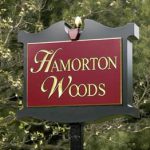On October 14, 1644, William Penn was born in London, England, to Admiral Sir William Penn. In 1681, King Charles II granted him the province of Pennsylvania (meaning “Penn’s Woods”) in repayment of a debt owed to Penn’s father. The land, some 30,000 acres, comprised our present-day Kennett Borough, the townships of New Garden, Pennsbury, Kennett, and part of Pocopson, as well as several thousand acres in New Castle County.
The land that comprises Hamorton Woods was part of 5,000 acres William Penn granted Francis and George Rogers in 1681 after receiving the province from the King.
It is difficult to say who the first English settlers might have been, but it is known that the Lenape Indians were here before the European settlers. Indian Hannah, who has been called the “last of the Lenni-Lenapes,” was born just south of the junction of US Route 1 and Pennsylvania Route 52. She worked among settlers of the community and died in 1803.
The first recorded mention of Kennett Township was in February of 1705, when Henry Pierce, the Township Constable, appeared in court. Pennsbury Township was established in 1770, in response to a petition requesting that Kennett Township be divided into East and West Kennett Township for better representation.
During the Revolutionary War, British soldiers and Hessian mercenaries passed through Kennett on their way to Chadds Ford. Records indicate that preliminary skirmishes of the Battle of the Brandywine took place at the Anvil at Hamorton and near Old Kennett Meetinghouse, located on US Route 1 across the street from the entrance to Hamorton Woods. Most of the early settlers were English Quakers, some of whom were not inclined to support the colonial cause and were suspected by their neighbors of remaining loyal to the crown.
The Meetinghouse, now on the National Historic Register, is open for worship in the summer. The Meetinghouse was built in 1710, enlarged in 1719 and again in 1731.
During the War of 1812, an encampment of 3,000 soldiers under the command of General Bloomfield drilled his soldiers on the site of the present Kennett Square Borough Waterworks. He gave his name to the property, which supported a series of early mills in the Township and was owned by the Chambers family for over a century.
Prior to the Civil War, many of the Quakers were active in the “Underground Railroad” which aided runaway slaves in their effort to escape to Canada. Using railroad terminology, the persons transporting the runaways from one place to another were called “conductors” and the homes where they were concealed were known as “stations.”
The Longwood Meetinghouse, located behind the Longwood Fire Hall along US Route 1 and now home to the Chester County Conference and Visitors Bureau, a tourist information center, was established prior to 1850 by a group of Progressive Friends concerned with the abolition of slavery.
The early settlers were farmers, as the fertile soil was adaptable to diversified agricultural activities. Many farmers grew produce, which they took to markets in Philadelphia and Wilmington by horse and wagon over almost impassable roads. In the mid-1800’s, a group of merchants and farmers joined together to subscribe funds to build a turnpike from Kennett Square to Wilmington, now known as Kennett Pike. This remained a toll road for many years.
A new venture in specialized agriculture began in Kennett Township about 1895, when several residents began growing flowers and vegetables under glass. Greenhouses appeared throughout the Township, some of which have survived and are still active today, growing principally roses and carnations.
The specialty which was to make Chester County world-renowned began about 1885, when William Swayne, a successful florist in Kennett Square, conceived the idea of growing mushrooms beneath his greenhouse benches. He sent to England for spawn, and the results were sufficiently encouraging to make him decide that a separate building would make it possible to control the growing conditions for mushroom culture. He built the first mushroom house in the area, and his son, J. Bancroft Swayne, returning from college, took over the mushroom business and made it a commercial success.
In close proximity to Hamorton Woods is Longwood Gardens. Known for its flowers, colored fountains, greenhouses, and gardens, the Gardens began in 1906. The land, over 1,000 acres, dates back to 1700. In the early days, the land was known as “Pierce’s Park” after George Pierce, an original owner who established an arboretum on the property. Now the largest public garden in North America, Longwood Gardens has been placed on the National Register of Historic Sites.
Hamorton Woods was developed in the early 1960’s. The construction of the pond took place in 1963 over the foundation of a barn used to raise cattle and turkeys. The farm at the entrance of Hamorton Woods was known as Ring Run Farm and was mentioned in “The Story of Kennett” by Bayard Taylor as “The House on Philadelphia Pike.” It was so named for the brook, which starts across the pike on the present Longwood grounds and meanders through Hamorton Woods.
The heritage of Hamorton Woods and the surrounding area is too rich to be forgotten. Many of the people and places have undergone significant changes during the more than three centuries of its recorded history. As you walk the trails through Hamorton Woods, take pride in those who walked before us and in those who fought to give us the opportunity to do so.


